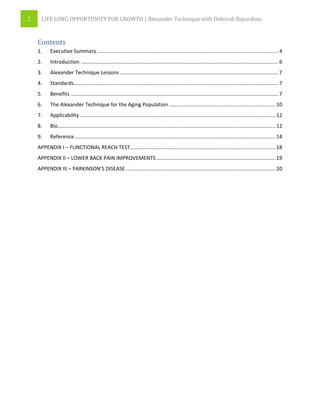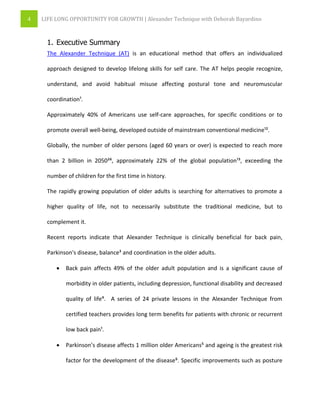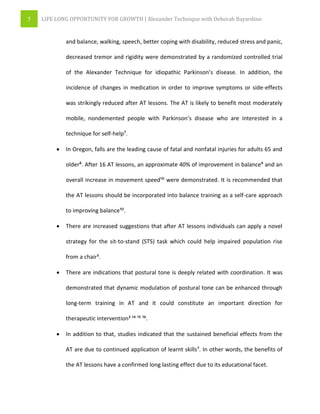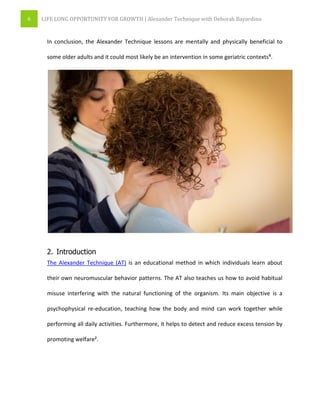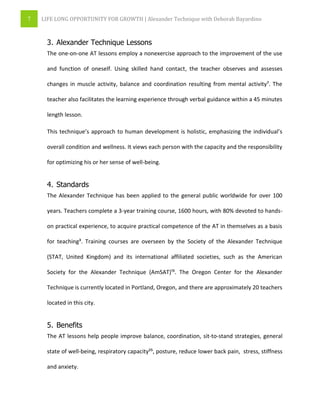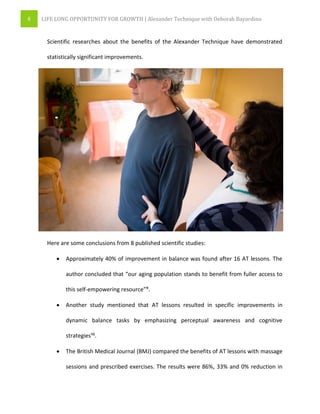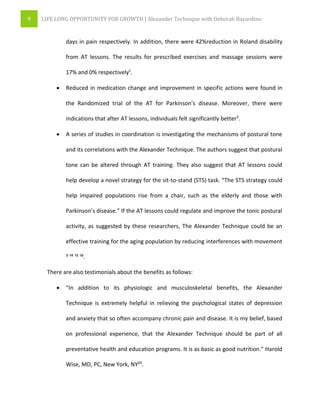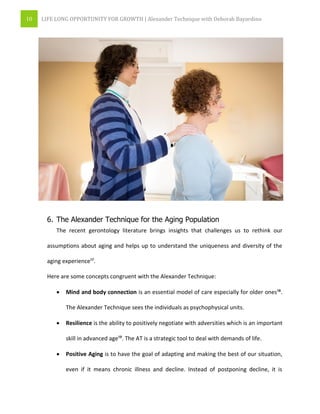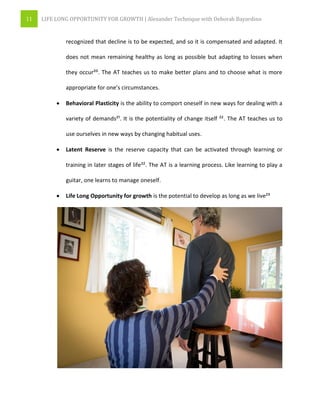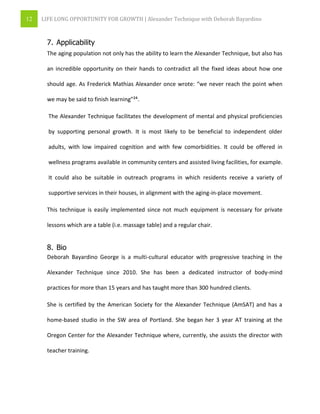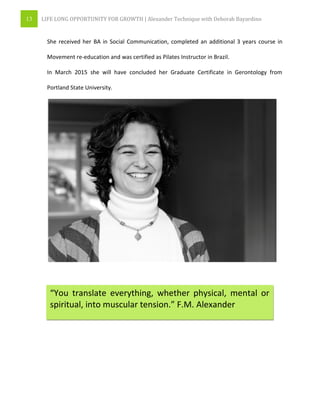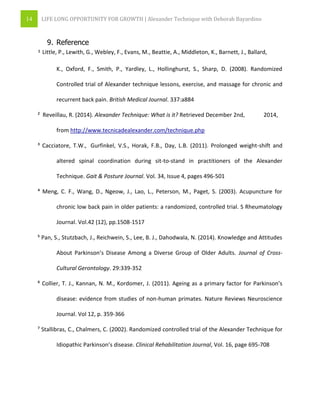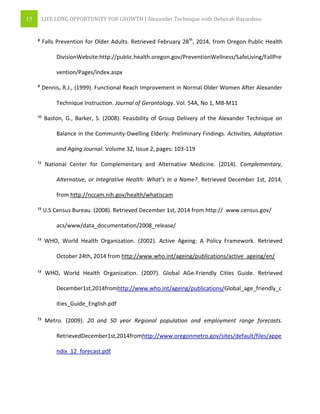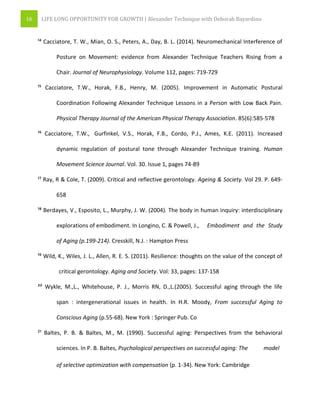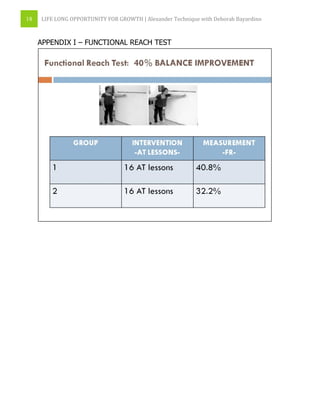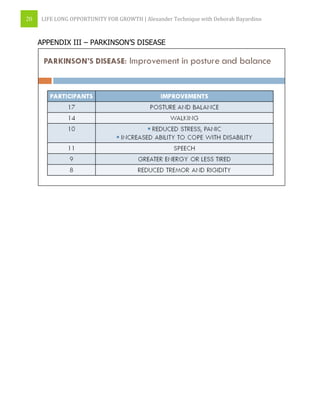InternshipProjectDEB
- 2. 2 LIFE LONG OPPORTUNITY FOR GROWTH | Alexander Technique with Deborah Bayardino Contents 1. Executive Summary..............................................................................................................................4 2. Introduction .........................................................................................................................................6 3. Alexander Technique Lessons ..............................................................................................................7 4. Standards..............................................................................................................................................7 5. Benefits ................................................................................................................................................7 6. The Alexander Technique for the Aging Population ..........................................................................10 7. Applicability........................................................................................................................................12 8. Bio.......................................................................................................................................................12 9. Reference ...........................................................................................................................................14 APPENDIX I – FUNCTIONAL REACH TEST.....................................................................................................18 APPENDIX II – LOWER BACK PAIN IMPROVEMENTS...................................................................................19 APPENDIX III – PARKINSON’S DISEASE........................................................................................................20
- 3. 3 LIFE LONG OPPORTUNITY FOR GROWTH | Alexander Technique with Deborah Bayardino
- 4. 4 LIFE LONG OPPORTUNITY FOR GROWTH | Alexander Technique with Deborah Bayardino 1. Executive Summary The Alexander Technique (AT) is an educational method that offers an individualized approach designed to develop lifelong skills for self care. The AT helps people recognize, understand, and avoid habitual misuse affecting postural tone and neuromuscular coordination¹. Approximately 40% of Americans use self-care approaches, for specific conditions or to promote overall well-being, developed outside of mainstream conventional medicine¹². Globally, the number of older persons (aged 60 years or over) is expected to reach more than 2 billion in 2050²⁶, approximately 22% of the global population¹³, exceeding the number of children for the first time in history. The rapidly growing population of older adults is searching for alternatives to promote a higher quality of life, not to necessarily substitute the traditional medicine, but to complement it. Recent reports indicate that Alexander Technique is clinically beneficial for back pain, Parkinson's disease, balance³ and coordination in the older adults.  Back pain affects 49% of the older adult population and is a significant cause of morbidity in older patients, including depression, functional disability and decreased quality of life⁴. A series of 24 private lessons in the Alexander Technique from certified teachers provides long term benefits for patients with chronic or recurrent low back pain¹.  Parkinson’s disease affects 1 million older Americans⁵ and ageing is the greatest risk factor for the development of the disease⁶. Specific improvements such as posture
- 5. 5 LIFE LONG OPPORTUNITY FOR GROWTH | Alexander Technique with Deborah Bayardino and balance, walking, speech, better coping with disability, reduced stress and panic, decreased tremor and rigidity were demonstrated by a randomized controlled trial of the Alexander Technique for idiopathic Parkinson’s disease. In addition, the incidence of changes in medication in order to improve symptoms or side-effects was strikingly reduced after AT lessons. The AT is likely to benefit most moderately mobile, nondemented people with Parkinson’s disease who are interested in a technique for self-help⁷.  In Oregon, falls are the leading cause of fatal and nonfatal injuries for adults 65 and older⁸. After 16 AT lessons, an approximate 40% of improvement in balance⁹ and an overall increase in movement speed¹⁰ were demonstrated. It is recommended that the AT lessons should be incorporated into balance training as a self-care approach to improving balance¹⁰.  There are increased suggestions that after AT lessons individuals can apply a novel strategy for the sit-to-stand (STS) task which could help impaired population rise from a chair³.  There are indications that postural tone is deeply related with coordination. It was demonstrated that dynamic modulation of postural tone can be enhanced through long-term training in AT and it could constitute an important direction for therapeutic intervention³ ¹⁴ ¹⁵ ¹⁶.  In addition to that, studies indicated that the sustained beneficial effects from the AT are due to continued application of learnt skills⁷. In other words, the benefits of the AT lessons have a confirmed long lasting effect due to its educational facet.
- 6. 6 LIFE LONG OPPORTUNITY FOR GROWTH | Alexander Technique with Deborah Bayardino In conclusion, the Alexander Technique lessons are mentally and physically beneficial to some older adults and it could most likely be an intervention in some geriatric contexts⁹. 2. Introduction The Alexander Technique (AT) is an educational method in which individuals learn about their own neuromuscular behavior patterns. The AT also teaches us how to avoid habitual misuse interfering with the natural functioning of the organism. Its main objective is a psychophysical re-education, teaching how the body and mind can work together while performing all daily activities. Furthermore, it helps to detect and reduce excess tension by promoting welfare².
- 7. 7 LIFE LONG OPPORTUNITY FOR GROWTH | Alexander Technique with Deborah Bayardino 3. Alexander Technique Lessons The one-on-one AT lessons employ a nonexercise approach to the improvement of the use and function of oneself. Using skilled hand contact, the teacher observes and assesses changes in muscle activity, balance and coordination resulting from mental activity⁷. The teacher also facilitates the learning experience through verbal guidance within a 45 minutes length lesson. This technique’s approach to human development is holistic, emphasizing the individual’s overall condition and wellness. It views each person with the capacity and the responsibility for optimizing his or her sense of well-being. 4. Standards The Alexander Technique has been applied to the general public worldwide for over 100 years. Teachers complete a 3-year training course, 1600 hours, with 80% devoted to hands- on practical experience, to acquire practical competence of the AT in themselves as a basis for teaching³. Training courses are overseen by the Society of the Alexander Technique (STAT, United Kingdom) and its international affiliated societies, such as the American Society for the Alexander Technique (AmSAT)¹⁵. The Oregon Center for the Alexander Technique is currently located in Portland, Oregon, and there are approximately 20 teachers located in this city. 5. Benefits The AT lessons help people improve balance, coordination, sit-to-stand strategies, general state of well-being, respiratory capacity²⁵, posture, reduce lower back pain, stress, stiffness and anxiety.
- 8. 8 LIFE LONG OPPORTUNITY FOR GROWTH | Alexander Technique with Deborah Bayardino Scientific researches about the benefits of the Alexander Technique have demonstrated statistically significant improvements. Here are some conclusions from 8 published scientific studies:  Approximately 40% of improvement in balance was found after 16 AT lessons. The author concluded that “our aging population stands to benefit from fuller access to this self-empowering resource”⁹.  Another study mentioned that AT lessons resulted in specific improvements in dynamic balance tasks by emphasizing perceptual awareness and cognitive strategies¹⁰.  The British Medical Journal (BMJ) compared the benefits of AT lessons with massage sessions and prescribed exercises. The results were 86%, 33% and 0% reduction in
- 9. 9 LIFE LONG OPPORTUNITY FOR GROWTH | Alexander Technique with Deborah Bayardino days in pain respectively. In addition, there were 42%reduction in Roland disability from AT lessons. The results for prescribed exercises and massage sessions were 17% and 0% respectively¹.  Reduced in medication change and improvement in specific actions were found in the Randomized trial of the AT for Parkinson’s disease. Moreover, there were indications that after AT lessons, individuals felt significantly better⁷.  A series of studies in coordination is investigating the mechanisms of postural tone and its correlations with the Alexander Technique. The authors suggest that postural tone can be altered through AT training. They also suggest that AT lessons could help develop a novel strategy for the sit-to-stand (STS) task. “The STS strategy could help impaired populations rise from a chair, such as the elderly and those with Parkinson’s disease.” If the AT lessons could regulate and improve the tonic postural activity, as suggested by these researchers, The Alexander Technique could be an effective training for the aging population by reducing interferences with movement ³ ¹⁴ ¹⁵ ¹⁶. There are also testimonials about the benefits as follows:  “In addition to its physiologic and musculoskeletal benefits, the Alexander Technique is extremely helpful in relieving the psychological states of depression and anxiety that so often accompany chronic pain and disease. It is my belief, based on professional experience, that the Alexander Technique should be part of all preventative health and education programs. It is as basic as good nutrition.” Harold Wise, MD, PC, New York, NY²⁷.
- 10. 10 LIFE LONG OPPORTUNITY FOR GROWTH | Alexander Technique with Deborah Bayardino 6. The Alexander Technique for the Aging Population The recent gerontology literature brings insights that challenges us to rethink our assumptions about aging and helps up to understand the uniqueness and diversity of the aging experience¹⁷. Here are some concepts congruent with the Alexander Technique:  Mind and body connection is an essential model of care especially for older ones¹⁸. The Alexander Technique sees the individuals as psychophysical units.  Resilience is the ability to positively negotiate with adversities which is an important skill in advanced age¹⁹. The AT is a strategic tool to deal with demands of life.  Positive Aging is to have the goal of adapting and making the best of our situation, even if it means chronic illness and decline. Instead of postponing decline, it is
- 11. 11 LIFE LONG OPPORTUNITY FOR GROWTH | Alexander Technique with Deborah Bayardino recognized that decline is to be expected, and so it is compensated and adapted. It does not mean remaining healthy as long as possible but adapting to losses when they occur²⁰. The AT teaches us to make better plans and to choose what is more appropriate for one’s circumstances.  Behavioral Plasticity is the ability to comport oneself in new ways for dealing with a variety of demands²¹. It is the potentiality of change itself ²². The AT teaches us to use ourselves in new ways by changing habitual uses.  Latent Reserve is the reserve capacity that can be activated through learning or training in later stages of life²². The AT is a learning process. Like learning to play a guitar, one learns to manage oneself.  Life Long Opportunity for growth is the potential to develop as long as we live²³
- 12. 12 LIFE LONG OPPORTUNITY FOR GROWTH | Alexander Technique with Deborah Bayardino 7. Applicability The aging population not only has the ability to learn the Alexander Technique, but also has an incredible opportunity on their hands to contradict all the fixed ideas about how one should age. As Frederick Mathias Alexander once wrote: “we never reach the point when we may be said to finish learning”²⁴. The Alexander Technique facilitates the development of mental and physical proficiencies by supporting personal growth. It is most likely to be beneficial to independent older adults, with low impaired cognition and with few comorbidities. It could be offered in wellness programs available in community centers and assisted living facilities, for example. It could also be suitable in outreach programs in which residents receive a variety of supportive services in their houses, in alignment with the aging-in-place movement. This technique is easily implemented since not much equipment is necessary for private lessons which are a table (i.e. massage table) and a regular chair. 8. Bio Deborah Bayardino George is a multi-cultural educator with progressive teaching in the Alexander Technique since 2010. She has been a dedicated instructor of body-mind practices for more than 15 years and has taught more than 300 hundred clients. She is certified by the American Society for the Alexander Technique (AmSAT) and has a home-based studio in the SW area of Portland. She began her 3 year AT training at the Oregon Center for the Alexander Technique where, currently, she assists the director with teacher training.
- 13. 13 LIFE LONG OPPORTUNITY FOR GROWTH | Alexander Technique with Deborah Bayardino She received her BA in Social Communication, completed an additional 3 years course in Movement re-education and was certified as Pilates Instructor in Brazil. In March 2015 she will have concluded her Graduate Certificate in Gerontology from Portland State University. “You translate everything, whether physical, mental or spiritual, into muscular tension.” F.M. Alexander
- 14. 14 LIFE LONG OPPORTUNITY FOR GROWTH | Alexander Technique with Deborah Bayardino 9. Reference ¹ Little, P., Lewith, G., Webley, F., Evans, M., Beattie, A., Middleton, K., Barnett, J., Ballard, K., Oxford, F., Smith, P., Yardley, L., Hollinghurst, S., Sharp, D. (2008). Randomized Controlled trial of Alexander technique lessons, exercise, and massage for chronic and recurrent back pain. British Medical Journal. 337:a884 ² Reveillau, R. (2014). Alexander Technique: What is it? Retrieved December 2nd, 2014, from http://www.tecnicadealexander.com/technique.php ³ Cacciatore, T.W., Gurfinkel, V.S., Horak, F.B., Day, L.B. (2011). Prolonged weight-shift and altered spinal coordination during sit-to-stand in practitioners of the Alexander Technique. Gait & Posture Journal. Vol. 34, Issue 4, pages 496-501 ⁴ Meng, C. F., Wang, D., Ngeow, J., Lao, L., Peterson, M., Paget, S. (2003). Acupuncture for chronic low back pain in older patients: a randomized, controlled trial. S Rheumatology Journal. Vol.42 (12), pp.1508-1517 ⁵ Pan, S., Stutzbach, J., Reichwein, S., Lee, B. J., Dahodwala, N. (2014). Knowledge and Attitudes About Parkinson’s Disease Among a Diverse Group of Older Adults. Journal of Cross- Cultural Gerontology. 29:339-352 ⁶ Collier, T. J., Kannan, N. M., Kordomer, J. (2011). Ageing as a primary factor for Parkinson’s disease: evidence from studies of non-human primates. Nature Reviews Neuroscience Journal. Vol 12, p. 359-366 ⁷ Stallibras, C., Chalmers, C. (2002). Randomized controlled trial of the Alexander Technique for Idiopathic Parkinson’s disease. Clinical Rehabilitation Journal, Vol. 16, page 695-708
- 15. 15 LIFE LONG OPPORTUNITY FOR GROWTH | Alexander Technique with Deborah Bayardino ⁸ Falls Prevention for Older Adults. Retrieved February 28th , 2014, from Oregon Public Health DivisionWebsite:http://public.health.oregon.gov/PreventionWellness/SafeLiving/FallPre vention/Pages/index.aspx ⁹ Dennis, R.J., (1999). Functional Reach Improvement in Normal Older Women After Alexander Technique Instruction. Journal of Gerontology. Vol. 54A, No 1, M8-M11 ¹⁰ Baston, G., Barker, S. (2008). Feasibility of Group Delivery of the Alexander Technique on Balance in the Community-Dwelling Elderly: Preliminary Findings. Activities, Adaptation and Aging Journal. Volume 32, Issue 2, pages: 103-119 ¹² National Center for Complementary and Alternative Medicine. (2014). Complementary, Alternative, or Integrative Health: What’s In a Name?. Retrieved December 1st, 2014, from http://nccam.nih.gov/health/whatiscam ¹³ U.S Census Bureau. (2008). Retrieved December 1st, 2014 from http:// www.census.gov/ acs/www/data_documentation/2008_release/ ¹³ WHO, World Health Organization. (2002). Active Ageing: A Policy Framework. Retrieved October 24th, 2014 from http://www.who.int/ageing/publications/active_ageing/en/ ¹³ WHO, World Health Organization. (2007). Global AGe-Friendly Cities Guide. Retrieved December1st,2014fromhttp://www.who.int/ageing/publications/Global_age_friendly_c ities_Guide_English.pdf ¹³ Metro. (2009). 20 and 50 year Regional population and employment range forecasts. RetrievedDecember1st,2014fromhttp://www.oregonmetro.gov/sites/default/files/appe ndix_12_forecast.pdf
- 16. 16 LIFE LONG OPPORTUNITY FOR GROWTH | Alexander Technique with Deborah Bayardino ¹⁴ Cacciatore, T. W., Mian, O. S., Peters, A., Day, B. L. (2014). Neuromechanical Interference of Posture on Movement: evidence from Alexander Technique Teachers Rising from a Chair. Journal of Neurophysiology. Volume 112, pages: 719-729 ¹⁵ Cacciatore, T.W., Horak, F.B., Henry, M. (2005). Improvement in Automatic Postural Coordination Following Alexander Technique Lessons in a Person with Low Back Pain. Physical Therapy Journal of the American Physical Therapy Association. 85(6):585-578 ¹⁶ Cacciatore, T.W., Gurfinkel, V.S., Horak, F.B., Cordo, P.J., Ames, K.E. (2011). Increased dynamic regulation of postural tone through Alexander Technique training. Human Movement Science Journal. Vol. 30. Issue 1, pages 74-89 ¹⁷ Ray, R & Cole, T. (2009). Critical and reflective gerontology. Ageing & Society. Vol 29. P. 649- 658 ¹⁸ Berdayes, V., Esposito, L., Murphy, J. W. (2004). The body in human inquiry: interdisciplinary explorations of embodiment. In Longino, C. & Powell, J., Embodiment and the Study of Aging (p.199-214). Cresskill, N.J. : Hampton Press ¹⁹ Wild, K., Wiles, J. L., Allen, R. E. S. (2011). Resilience: thoughts on the value of the concept of critical gerontology. Aging and Society. Vol: 33, pages: 137-158 ²⁰ Wykle, M.,L., Whitehouse, P. J., Morris RN, D.,L.(2005). Successful aging through the life span : intergenerational issues in health. In H.R. Moody, From successful Aging to Conscious Aging (p.55-68). New York : Springer Pub. Co ²¹ Baltes, P. B. & Baltes, M., M. (1990). Successful aging: Perspectives from the behavioral sciences. In P. B. Baltes, Psychological perspectives on successful aging: The model of selective optimization with compensation (p. 1-34). New York: Cambridge
- 17. 17 LIFE LONG OPPORTUNITY FOR GROWTH | Alexander Technique with Deborah Bayardino ²² Rabello de Castro, L., Rabello de Castro, G. (2001). Coping in old age: Considerations from the point of view of case studies from Brazil. Indian Journal of Gerontology. Vol. 15, issue1-2, p. 183 ²³ Papalia, D.E., Cap, C.J., & Feldman, R.D. (2006). Adult Development and Aging, 3rd Ed. McGraw-Hill ²⁴ Alexander, F. M. (2004). Constructive Conscious Control of the Individual (3rd ed.). London, UK: Mouritz ²⁵ Austin, J. H. M., Ausubel, P. (1992). Enhanced Respiratory Muscular Function in Normal Adults after Lessons in Proprioceptive Musculoskeletal Education without Exercises. CHEST Journal. Vol.102 (2), p.486 (5). ²⁶ United Nations Department of Economic and Social Affairs ǀ Population Division. (2013). World Population Ageing 2013. Retrieved December 15th , 2014 from http://www.un.org/en/development/desa/population/publications/pdf/ageing/WorldP opulationAgeing2013.pdf ²⁷ American Society for the Alexander Technique (AmSAT) (2014). What have doctors said about the Alexander Technique?. Retrieved December 16th from http://www.amsatonline.org/faq#t19n677
- 18. 18 LIFE LONG OPPORTUNITY FOR GROWTH | Alexander Technique with Deborah Bayardino APPENDIX I – FUNCTIONAL REACH TEST
- 19. 19 LIFE LONG OPPORTUNITY FOR GROWTH | Alexander Technique with Deborah Bayardino APPENDIX II – LOWER BACK PAIN IMPROVEMENTS
- 20. 20 LIFE LONG OPPORTUNITY FOR GROWTH | Alexander Technique with Deborah Bayardino APPENDIX III – PARKINSON’S DISEASE


